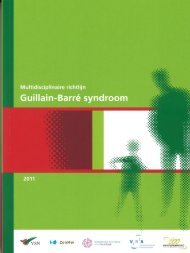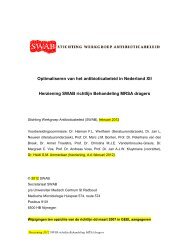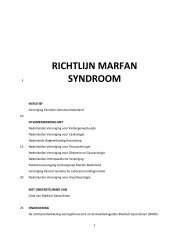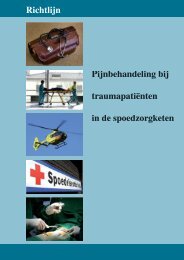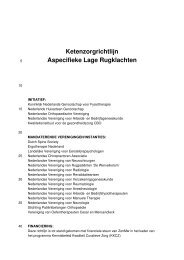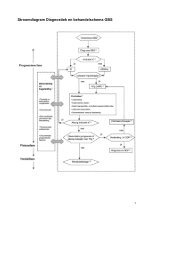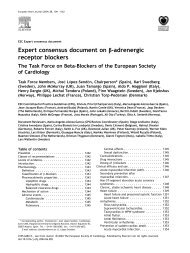Richtlijn: Mammacarcinoom (2.0) - Kwaliteitskoepel
Richtlijn: Mammacarcinoom (2.0) - Kwaliteitskoepel
Richtlijn: Mammacarcinoom (2.0) - Kwaliteitskoepel
Create successful ePaper yourself
Turn your PDF publications into a flip-book with our unique Google optimized e-Paper software.
2. TNM Classification of Malignant Tumours 2010<br />
Rules for Classification<br />
The classification applies only to carcinomas and concerns the male as well as the female breast (ICD-O<br />
C50). There should be histological confirmation of the disease. The anatomical subsite of origin should be<br />
recorded but is not considered in classification. In the case of multiple simultaneous primary tumours in one<br />
breast, the tumour with the highest T category should be used for classification. Simultaneous bilateral<br />
breast cancers should be classified independently to permit division of cases by histological type.<br />
The following are the procedures for assessing T, N, and M categories:<br />
T categories Physical examination and imaging, e.g., mammography<br />
N categories Physical examination and imaging<br />
M categories Physical examination and imaging<br />
Anatomical Subsites<br />
• Nipple (C50.0)<br />
• Central portion (C50.1)<br />
• Upper-inner quadrant (C50.2)<br />
• Lower-inner quadrant (C50.3)<br />
• Upper-outer quadrant (C50.4)<br />
• Lower-outer quadrant (C50.5)<br />
• Axillary tail (C50.6)<br />
Regional Lymph Nodes<br />
The regional lymph nodes are:<br />
• Axillary (ipsilateral): interpectoral (Rotter) nodes and lymph nodes along the axillary vein and its<br />
tributaries, which may be divided into the following levels:<br />
♦ Level I (low-axilla): lymph nodes lateral to the lateral border of pectoralis minor muscle.<br />
♦ Level II (mid-axilla): lymph nodes between the medial and lateral borders of the pectoralis<br />
minor muscle and the interpectoral (Rotter) lymph nodes.<br />
♦ Level III (apical axilla): apical lymph nodes and those medial to the medial margin of the<br />
pectoralis minor muscle, excluding those designated as subclavicular or infraclavicular.<br />
• Infraclavicular (subclavicular) (ipsilateral).<br />
• Internal mammary (ipsilateral): lymph nodes in the intercostal spaces along the edge of the<br />
sternum in the endothoracic fascia.<br />
• Supraclavicular (ipsilateral).<br />
Note: ntramammary lymph nodes are coded as axillary lymph nodes Level I. Any other lymph node<br />
metastasis is coded as a distant metastasis (M1), including cervical or contralateral internal mammary<br />
lymph nodes.<br />
TNM Clinical Classification<br />
<strong>Richtlijn</strong>: <strong>Mammacarcinoom</strong> (<strong>2.0</strong>)<br />
T - Primary Tumour<br />
T X Primary tumour cannot be assessed<br />
T 0 No evidence of primary tumour<br />
T is Carcinoma in situ<br />
T is (DCIS) Ductal carcinoma in situ<br />
T is (LCIS) Lobular carcinoma in situ<br />
T is (Paget) Paget disease of the nipple not associated with invasive carcinoma and/or carcinoma in situ<br />
(DCIS and/or LCIS) in the underlying breast parenchyma. Carcinomas in the breast parenchyma<br />
associated with Paget disease are categorized based on the size and characteristics of the parenchymal<br />
disease, although the presence of Paget disease should still be noted.<br />
T 1 Tumour 2 cm or less in greatest dimension 1<br />
T 1mic Microinvasion 0,1 cm or less in greatest dimension<br />
T 1a More than 0,1 cm but not more than 0,5 cm in greatest dimension<br />
T 1b More than 0,5 cm but not more than 1 cm in greatest dimension<br />
T 1c More than 1 cm but not more than 2 cm in greatest dimension<br />
T 2 Tumour more than 2 cm but not more than 5 cm in greatest dimension<br />
03/27/2012 <strong>Mammacarcinoom</strong> (<strong>2.0</strong>) 195




